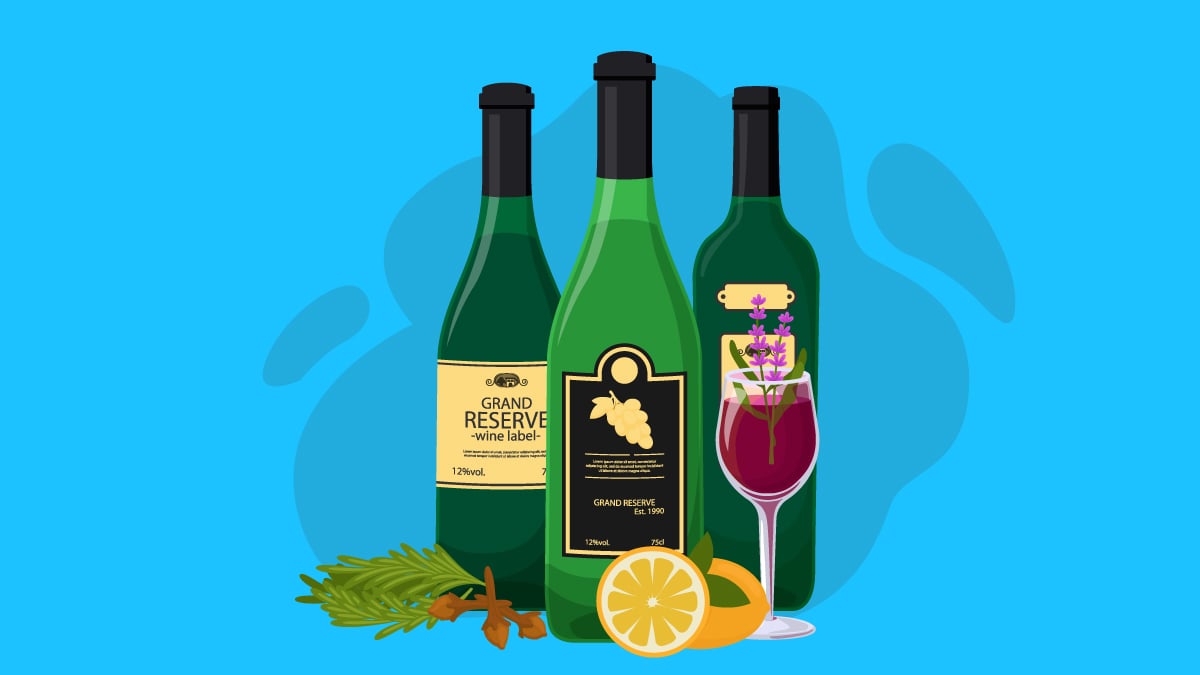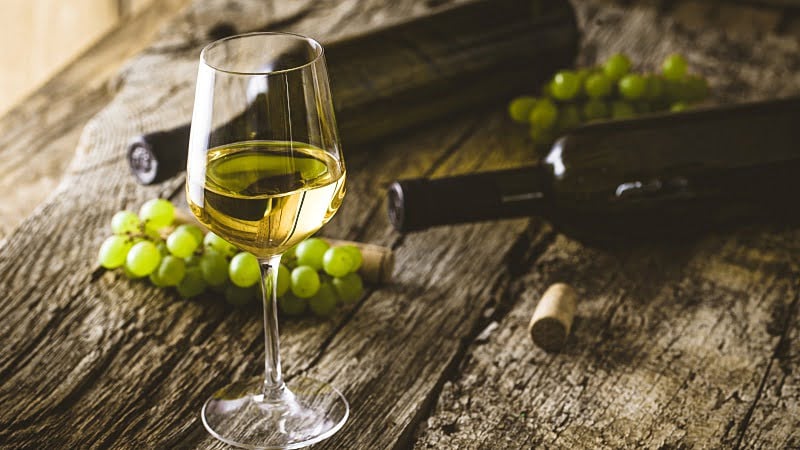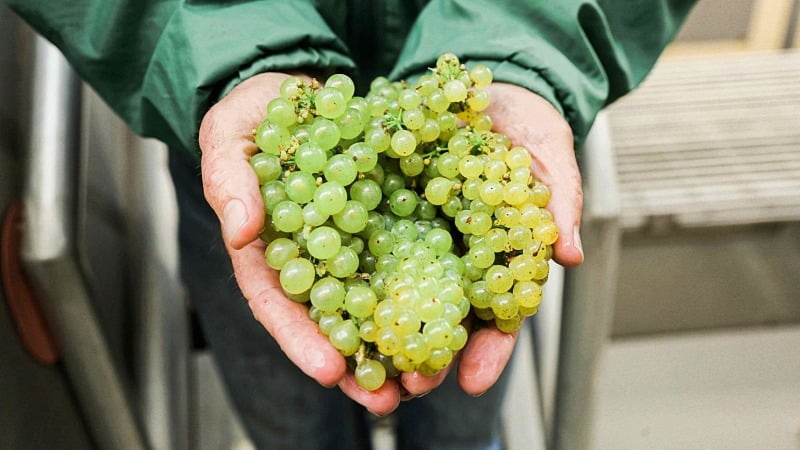Terpenes in Wine: Where Wine Flavors Come From

There are over 30,000 known terpenes in the plant kingdom. They give each plant its unique scent, color, and aroma.
These natural compounds make their way into everyday products we enjoy, including wine.
The flavor profiles of different grapes, vintages, and winemaking styles are heavily influenced by terpenes.
There is more than one way terpenes can present themselves in your favorite wine.
Find out what terpenes are present in wine and how terpenes can be added to enhance or change a wine’s flavor profile.
What are Terpenes?
Terpenes are chains of isoprene units (C5H8). These units can be linear or in a cyclical chain. Terpenes can consist of 2,3,4 or 6 isoprene units.
The number of units determines the specific characteristics of the terpene.
Terpenes are naturally occurring in many (but not all) plants. It gives them their unique smell and taste.
Some are included in pharmaceuticals because of their natural health effects on the body.
Terpenes are what gives lemons their citrus scent and nutmeg its characteristic warm and spicy flavor.
To learn more about terpenes, read this article What Are Terpenes?.
How do Terpenes Affect Wine?
When you have a bottle of wine high in terpenes, the telltale sign is an intense aroma when you open the bottle.
They affect the profile of wine in 3 ways,
- Impart unique smell and taste
- Compliment other flavors
- Help prevent the wine from going “off”
Terpenes also have naturally occurring antioxidant, anti-inflammatory, and calming effects. They pass this into wine as well.
List of Terpenes Present in Wine
Each grape will have a different terpene profile that will impart flavor and aroma into the wine. But there are several common terpenes present in wine.
1. Geraniol
This compound has a strong floral, rose-like aroma. This terpene is usually present more in white wine.
The geraniol content of grapes is largely attributed to the terroir (growing region), climate, and soil conditions. It’s present in higher concentrations in white wine because it’s primarily found inside the grape rather than in the grape skin.
Red wine uses the grape skin, which imparts many more compounds that can overpower the geraniol content of the wine.
2. Linalool
This monoterpene gives off a floral, lavender scent. It’s commonly found alongside geraniol. Linalool, like geraniol, is more abundant in white wine compared to red wine.
The aroma of linalool is described as having hints of orange blossom, bay leaf, and lily.
3. Citronellol
This terpene is the characteristic scent used in mosquito repellants. It’s citrusy but with more sweet undertones.
This is one of the most easily distinguishable terpenes in a wine bouquet.
4. Nerol (A-Terpineol)
The aroma of nerol is somewhere between floral and citrus scents. This terpene can enhance the flavor of other terpenes in the wine but can be hard to pick out on its own.
5. Rotundone
This is a type of stable sesquiterpene. It’s found in the skin of red grapes. Since red wine is fermented with the skin on, this terpene is often present in red wines.
The flavor of this terpene can be hard to spot, but it has a very subtle spiciness to it.
6. Alpha-Pinene
This terpene gives pine needles their intense scent. But it’s also present in hearty herbs like rosemary and juniper. This terpene is commonly seen with 1,8-cineole, which gives a more subtle herbaceous smell (like a eucalyptus tree).
Learn more: What is Pinene Terpene?
What Other Factors Contribute to the Flavor of Wine?
A wine’s flavor and aroma come from natural compounds found in grapes and from chemical reactions during the fermentation process.
Terpenes add unique modifiers to the flavor — like hints of blueberry, lilac, or cinnamon, but they aren’t the only ones contributing to the flavor.
Here are some of the compounds in wine that are responsible for its unique flavor.
1. Esters
Esters develop during fermentation. They’re created by reactions between acid and alcohol.
As wine ages, these reactions continue back and forth. They produce fruity and floral aromas.
The constant reactions while the wine ages are why the smell of wine can change over time. As time goes on, more esters are formed, giving the wine a much more complex flavor.
2. Lactones
Generally, these compounds are imparted into the wine through oak barrels. It gives the wine creamy, toasted, or buttery notes.
Lactones are also created through malolactic fermentation. This is when tart malic acid converts to softer lactic acid.
3. Thiols
These are sulfur-based compounds. They are what give a wine its minerality or stone characteristics. This can also cause a fruity smell to develop.
Small amounts of sulfates are also added to preserve the wine. But too much sulfur can cause an unpleasant garlic smell and is a wine fault.
4. Aldehydes
Aldehydes give off vanilla, woody, and herb characteristics. Oak barrels can impart aldehydes into the wine.
5. Prayzines
Prayzines are stable grapes that give off a bell pepper aroma or another leafy vegetable aroma. These compounds are naturally occurring in certain grape varietals.
6. Ketones
Certain ketones are present in grapes that can give off floral notes. Some are created as a by-product of malolactic fermentation.
These are similar to lactones and give a buttery or creamy characteristic to the wine.
7. Mercaptans
These compounds are more volatile sulfur molecules. They are caused by the fermentation process. They help give tropical notes to the wine –– like passionfruit, pineapple, or coconut.
Can Terpenes be Added to Wine?
Terpenes are commonly added to food, spirits, beers, and other beverages. But terpenes are not typically added to the wine.
Instead, techniques are used to bring out certain terpenes the winemaker wants in the finished product.
Combining different grapes can impact the levels of terpenes in the final wine. Winemakers can also use different strains of yeast in the fermentation process. The yeast will break down the sugar. The reaction between the primary sugar metabolites will create secondary metabolites (terpenes).
The addition of milk, lemon juice, or other acids can cause additional reactions in the wine during production to impart other unique flavor profiles.
What are the Different Types of Terpenes?
Terpenes are divided into categories based on how many isoprene units they have.
1. Monoterpenes
Monoterpenes are made of 2 isoprene units with at least 1 double bond. They’re mostly present in the essential oils of a plant. These compounds give an intense aroma and flavor.
Monoprenes are also mixed to create oil-based fragrances and cosmetics. They are used in pharmaceuticals for their positive health effects. They also make up natural flavorings that can be added to food, spirits, and beverages.
Emerging evidence has found that these compounds have natural antibacterial properties that can be carried into essential oils.
2. Sesquiterpenes
Sesquiterpenes can be linear in structure (like monoterpenes) or cyclic, bicyclic, or tricyclic (a series of rings). They consist of 3 isoprene units with 15 carbon atoms.
They have antimicrobial and antibacterial properties and are being studied for their potential medical applications. They are also known for their calming effects.
3. Diterpenes
Diterpenes (C20H32) have 4 isoprene units. They are biosynthesized by plants, some animals, and fungi. They are more commonly found in cyclic carbon chain formations (like sesquiterpenes).
These compounds have antimicrobial, antibacterial, anti-inflammatory, and antifungal properties. Data from early studies have indicated certain diterpenes can also affect the cardiovascular system.
4. Sesterpenes
Sesterpenes have a more complex structure consisting of 5 isoprene units. They have antimicrobial, antifungal, antibacterial, and anti-inflammatory properties.
They are not as common as other forms of terpenes.
How Does the Winemaking Process Affect The Terpene Content
The length of the winemaking process may vary, but the steps will remain the same. The winemaker will adjust certain steps depending on the wine they are trying to produce.
Crushing the Grapes
This process extracts the juice from the grapes. Depending on the wine being produced, the skins will be left inside the wine or removed.
Wines with the skin left on during fermentation produce red wine — which imparts additional terpenes found only in the grape skins.
White wine has the skins removed, eliminating many of the stronger terpenes that compete for the lighter, floral terpenes inside the grape.
Fermentation
The grape juice is transferred into a barrel, concrete drum, or other storage vessels for fermentation. This allows natural yeast to break down the sugars and produce alcohol.
Depending on the wine or flavor profile wanted, winemakers will use different yeast or wooden barrels.
The wood contains terpenes and other flavoring agents, gradually diffusing into the wine as it ferments.
Winemakers can dramatically alter the flavor of wine depending on the type of wood they choose to use for their barrels.
Bottling & Aging
Once the wine is ready to be bottled, workers will bottle it by hand or use automated machinery to speed up the bottling process.
At this point, other extracts or components can be mixed with the wine before it’s bottled to alter the flavor even more.
Most winemakers will then store the wine for a few months to allow the flavors inside to stabilize and level out before it’s put on sale.
In Summary: How do Terpenes Work in Wine?
Terpenes give plants their unique smell and taste, and in some cases, their color. This includes the grapes used to make wine, the wooden barrels used to age the wine, and many other plant extracts that may alter the flavor of the wine.
Each wine has a complex bouquet –– flavor and aroma profile. This flavor comes from a combination of sugars, alcohols, terpenes, and a host of other aromatic compounds that are either added or produced during the fermentation process.
There are so many variables contributing to the flavor of wine it will make your head spin. There’s a nearly infinite array of flavors and qualities possible for wine. Some of these flavor components are so subtle, only a highly trained palate can detect them at all.



